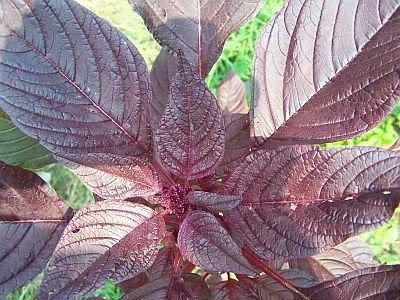
So I have been trying for years to get a true red color out of this Hopi Red Amaranth. I have researched most everything I can get my hands on, and have started to wonder if it is at all possible to get red dye for wool out of this plant.
Based on what I had read, (somewhere, I have forgotten the source) the plants this time around, were harvested before the flowers were in full bloom. The plants are sowing themselves freely in my garden now, and pop up like weeds. I was glad to chop them down. They were about 5 feet tall. I harvested a good arm full. The chickens are always interested in Amaranth of any kind....
I chopped up the entire plant, leaves, stems and flowers...and filled the turkey roaster with enough water to cover.
I cooked it down until the leaves lost all of the color. Then the entire pot was strained, and the cooked amaranth was served up to the chickens, who ate it right up while it was still steaming. It smelled like cooked spinach.
The day before, I had soaked my wool (Farmer Dave handspun) in a premordant of alum and cream of tartar...and let it stand overnight....it was ready to go into the dye bath. I let the wool simmer in the bath for about an hour, and then turned off the heat. It looked promising. The wool was allowed to cool and set overnight.
The next day, I noticed the dye did not exhaust....but I have never had it do that in the past either. The dye did strike, but alas, I was rewarded for my efforts with a mustard brown color once again. If anyone knows what I am doing wrong, or if there indeed is a way to achieve a red color on wool (not cornbread!)- please send me an email...you can find my address on the side bar.

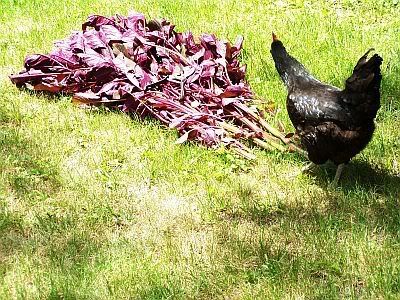
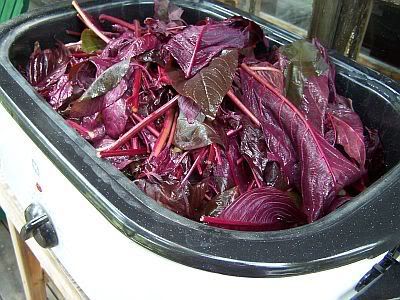

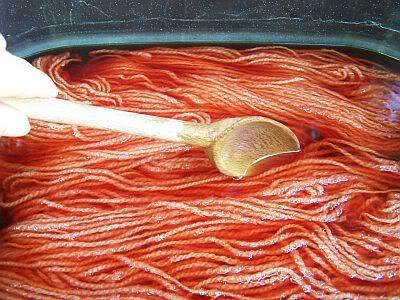
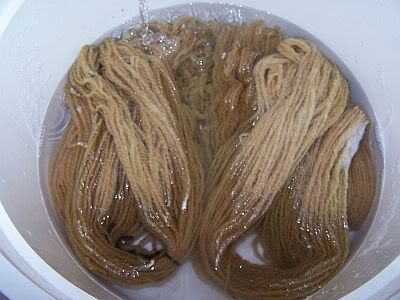


17 comments:
Mine came out a light yellow. I hope you learn something from this post as it grows like weeds in my garden also. They used the seed to dye the cornbread right?...maybe we should try the seed to dye the wool. It is worth a shot next year!
Very interesting - I'll ask around.
Ohhh....how disappointing. All that work. I though for sure as I followed the photos that you would end up with something vibrant. Wish I knew how to help.
Hi, Cat sent us over from the Sheep Thrills list. I am on the Naturaldyes list and it's possible that the cream of tartar turned it brown. I know that it works great with cochineal but on other red dyes changes it to browns. Particularly madder. You might want to try adding ammonia or something to make it more base instead of acid? I am very interested in your results as well. I have wanted to get some started in my yard for possible dye. Oh! Another thing is maybe it's the grain that's used for the dyeing. It seems like this is a possibility, but ?? It's fun to try this stuff for sure. Good luck!
Judy Jackson in Salt Lake
Thanks for the suggestions Judy.
I have tried the ammonia previously, you can check my archives (October of 2004). Any idea why the dye bath did not exhaust?
I had the best luck with vinegar, it was a very light salmon pink color. I haven't been able to find any documentation about this plant producing a red dye on wool.
I have been looking around for several years. Most seed suppliers sell this as a dye plant, but I am beginning to doubt the ability of the plant to produce a red color.
Hi,
Me too on coming over from Sheep Thrills and being on the NaturalDyes list.
Come on over, join in, and do a search of the archives for "amaranth." Seems the dye molecule is the same as for beets, not very fast. It's better used as a colorant in foods that will be kept cold. The Navajo apparently used it for food colorant, and it got into the dye literature that way.
Ruth Schooley in Los Angeles
Oh so disappointing!
I wonder if the Hopi Indians actually use it to dye their wools. My mom had a beautiful handwoven shawl that had a brilliant fire-engine red wool yarn. It was woven sometime in the late 1940s.
I don't know this plant but I have tried the same thing with beetroot but with no success , just a browny shade :(
Sorry I am no help to you
I grew this plant intending to use it for dye and noticed that everywhere it is mentioned it says that the flowers, not the plant, were used to make dye, however there does not seem to be any directions.
Check out project Gutenberg, it's a website with tons of e-books, I found one on soap making that has clarified a lot of issues and it had quite a few on dye making and fabric dying
Specifically "The dyeing of woollen fabrics" can be found on project Guttenberg and has a bit to say about amaranth.
I know this is a way old post, but on the off chance that you never figured out how to dye with amaranth, I found this: http://rosendame.blogspot.de/search/label/Amaranth%20hopi%20red%20dye%20Amaranthus%20cruentus%20x%20powellii
It's in German, I think, but it gave me the option to have it translated into English and it made sense about 3/4 of the time, which might be enough to get you some pretty pinks and lavenders that this lady created with amaranth. :)
The flowers make a nice red even when quite dilute&last years plants that survived the winter on the plains...indians use an amaranth plant to dye they vall it "hopi"
Hope this encourages you to try the flower/seed clusters!!
Have you tried using lower temperatures to set the dye? High temperatures could be breaking down the pigment & thereby changing the color from reddish to brown.
Have you tried using lower temperatures to set the dye? High temperatures could be breaking down the pigment & thereby changing the color from reddish to brown.
Saw an another site that got results from using lower temps. She sun dyed it and it came out beautifully.
Sun dye with amaranth. high heat is no good.
Post a Comment